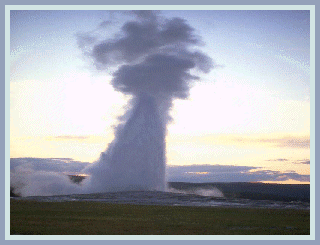

Old Faithful at Yellowstone National Park
Yellowstone National Park in Wyoming is home to some
of the most famous geysers in the world, including Old Faithful.
Old Faithful was named by the Washburn expedition
of 1870. They were impressed by its size and frequency.
It is not the biggest or most regular geyser in Yellowstone
but it is the biggest regular geyser. Furthermore, it has been
erupting in nearly the same fashion throughout the recorded
history of Yellowstone. Through the years, it has
become one of the most studied geysers in the park.
Mathematicians, statisticians, and dedicated observers
have analyzed it for many years. For example, a
direct relationship exists between the duration of
Old Faithful's eruption and the length of the following
interval. Short eruptions (around 2 minutes) lead to short
intervals (about 65 minutes); long eruptions (4 minutes or so)
lead to long intervals (about 94 minutes).
During a short eruption, less water and heat are discharged;
thus, they rebuild again in a short time. Longer eruptions
mean more water and heat are discharged and they
require more time to rebuild. As of August 2002,
the average interval was 94 minutes.
Old Faithful is a cone-type geyser. Its intervals range
from 35 to 120 minutes, its duration is 1 1/2 to 5
minutes and its height is 90 to 184 feet. During the
last decade or so, long interval eruptions have
become more common as a result, the average interval
for Old Fathful has increased to nearly 90 minutes.
Geysers are hot springs with narrow spaces in their plumbing,
usually near the surface. These constrictions prevent
water for circulating freely to the surface where heat
would escape. The deepest circulating water can
exceed the surface boiling point of 199° F / 93° C.
The surrounding pressure also increases with depth,
much as it does with depth in the ocean. Increased
pressure exerted by the enormous weight of the
overlying rock and water prevents the water from
vaporizing. As the water rises, steam forms.
Bubbling upward, steam expands as it nears the top
of the water column until the bubbles are too large
and numerous to pass freely through the constrictions.
At a critical point, the confined bubbles actually lift the
water above, causing the geyser to splash and overflow.
This decreases pressure on the system, and violent
boiling results. Tremendous amounts of steam force
water out of the vent, and the eruption begins. Water
is expelled faster than it enter the geyser's plumbing
system, and the heat and pressure gradually decrease.
The eruption stops when the water reservoir is
exhausted or when the gas bubbles diminish
enough to be able to rise without ejecting the water.
Geysers, fumaroles, and hot springs are generally
found in regions of young volcanic activity.
The major Geyser fields of the world found at:
Yellowstone National Park, Wyoming
Valley of Geysers, Kamchatka Peninsula (Siberia)
North Island, New Zealand
Iceland
Beowawe Geyser Field, Nevada
Steamboat Springs, Nevada
Umnak Island, Alaska (USA)
El Tatio (Chile)
Back To Famous Places & Events Index
Free Pet Newsletter
Pet Care Tips Directory
Animal Calendars, Posters, Shirts & Fun Stuff
Stuffed Plush Animals
Canine Care Tips
Feline Care Tips
Horse Care Tips
Site Map
Copyright ©
Choose To Prosper